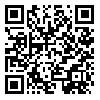Volume 5, Issue 1 (2-2024)
مطالعات فقه و حقوق رسانه 2024, 5(1): 251-279 |
Back to browse issues page
Download citation:
BibTeX | RIS | EndNote | Medlars | ProCite | Reference Manager | RefWorks
Send citation to:



BibTeX | RIS | EndNote | Medlars | ProCite | Reference Manager | RefWorks
Send citation to:
omidian D, ghadiri M, hoseini E. Analysis of Spousal Abuse in Selected Works of Iranian Female Filmmakers in the Light of Theoretical Criminology and Feminist Theories. مطالعات فقه و حقوق رسانه 2024; 5 (1) :251-279
URL: http://journal.refah.ac.ir/article-1-71-en.html
URL: http://journal.refah.ac.ir/article-1-71-en.html
Abstract: (714 Views)
The media, including cinema, always plays an important role in portraying the open and hidden realities of society in different fields and from different aspects, including the family. The phenomenon of spousal abuse is a global problem and is seen in various forms in social groups and classes with all their differences, and as one of the most important domestic violence, it overshadows the situation of women; Of course, in the meantime, husband, children, the elderly can also be exposed to these violence in various forms. This social and legal problem has attracted the attention of Iranian cinematographers, both men and women. In this research, two female directors and one female screenwriter, have considered the views of the causes and types of this phenomenon from the perspective of criminological theories and feminist themes in selected works (Mali and its untaken ways, under a smoky roof, and Time of love).
In order to collect information, the story of the films, dialogues and sequences related to the topic were qualitatively analyzed. In this research, after viewing the films, the etiology of spousal abuse was investigated in the light of 4 theories of differential associations, criminal subculture theory, rational theory and woman-oriented theory. The findings indicate that the effects of showing the causes of spousal abuse are consistent with criminological theories and feminist themes.
In order to collect information, the story of the films, dialogues and sequences related to the topic were qualitatively analyzed. In this research, after viewing the films, the etiology of spousal abuse was investigated in the light of 4 theories of differential associations, criminal subculture theory, rational theory and woman-oriented theory. The findings indicate that the effects of showing the causes of spousal abuse are consistent with criminological theories and feminist themes.
Type of Study: Research |
Subject:
Special
Received: 2023/10/9 | Accepted: 2024/03/5 | Published: 2023/09/27
Received: 2023/10/9 | Accepted: 2024/03/5 | Published: 2023/09/27
Send email to the article author
| Rights and permissions | |
 |
This work is licensed under a Creative Commons Attribution-NonCommercial 4.0 International License. |




